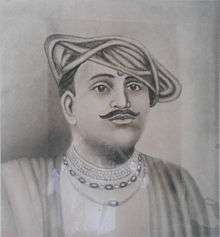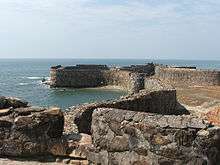Maratha Navy
| Maratha Navy | |
|---|---|
 | |
| Active | circa 1650-1750 |
| Country | India |
| Allegiance | Maratha Empire |
| Type | Navy |
| Size | Peak Size - Around 60 warships; 5,000 men |
| Commanders | |
| Daria Sarang (Admiral of the Mahratta Fleet)[1] | Supreme commander |
| Notable commanders |
|
The Maratha Navy refers to the naval wing of the armed forces of Maratha Empire, which existed from around mid-17th century to mid-18th century in India. The founder of Maratha Empire Chhatrapati Shivaji is considered as the Father of Indian Navy.[2]
Formative years
The legendary Maratha ruler Chhatrapati Shivaji, was the founding father of the naval arm of the Maratha Armed forces.
Historian Sir Jadunath Sarkar noted:
Nothing proves Shivaji’s genius as a born statesman more clearly than his creation of a navy and naval bases.[3]
In medieval India, the Muslim Rulers (such as Deccan Sultanates and Mughal Sultanate) mostly ignored the naval arm of their militaries, probably the reason was that they came from North and won decisively in land battles. This scenario however changed when the Portuguese arrived in India and started monopolizing and controlling trade on the western coast of India. Chhatrapati Shivaji realized the importance of a strong navy and the first keel of the Maratha naval vessel was laid down in a creek near Kalyan circa 1654.[4]
Shivaji took up the task of constructing multiple naval bases across the coast of present-day Maharashtra. He organized two fleets – one under the command of Admiral Mainak Bhandari and the other under Daulet Khan. The Maratha Navy consisted mostly of the native Konkani sailors, however it was commanded mostly by mercenaries including Siddis and Portuguese.[5] Circa 1659, the Maratha Navy consisted of around 20 warships. Hiring mercenaries was something not uncommon to the Maratha military culture and the Navy was not an exception to it. Shivaji hired a Portuguese naval officer named Rui Leitao Viegas to command his fleet; the Marathas wanted to get an insight into the Portuguese naval technology and capabilities. Probably that was the reason of employing Portuguese officers; further, the Marathas were fully aware of the Portuguese naval capabilities. It is worth mentioning that the Portuguese managed to convince their mercenary officers to discontinue the service of the Marathas, however the Portuguese allied with the Marathas when the latter were engaged in a war with the Mughals.[6]
The Battle of Surat of 1664 was a well-coordinated one, whereby the Marathas utilized their Army as well as Navy in synchronized fashion . In 1679, Shivaji annexed the island of Khanderi, which was 11 miles off the entrance to Mumbai. In response the English and the Siddis repeatedly attacked the island but were unable to oust the Marathas from the islands.[7] It was a stark reminder for the British, the Portuguese, and the Mughals that Shivaji was not only powerful on land, but was equally powerful at sea.
Circa 1674, during Shivaji's coronation, the Portuguese at Goa noted and acknowledged the Maratha Naval power and sent their emissary to Shivaji with gifts and signed a treaty of friendship. Around the same time, the Maratha Navy's strength was around 5,000 men and 57 warships. During its expedition to Karwar (present-day Karnataka), the navy possessed around 85 assorted Gallivats (warboat) ranging from 30 to 150 tons and 3 three-masted Gurabs/Grabs (warship).[8]
Under Admiral Kanhoji Angre

After the death of Admiral Sidhoji Gujar circa 1698, the Maratha Navy was able to survive only because of the extensive efforts of the legendary Admiral Kanhoji Angre. Under this new chief of Maratha Navy, the British naval power was checked along the western coast of India. Admiral Kanhoji Angre owed allegiance to the then supreme Maratha ruler Chhatrapati Shahu and his first minister Peshwa Balaji Vishwanath and managed to get their green light for building a naval presence on the western coast of India - Konkan. Under the leadership of Kanhoji, the Marathas developed naval base at Vijayadurg featuring dockyard facilities for building vessels, mounting guns, and making them sea-worthy. Their naval fleet then consisted of 10 Gurabs/Grabs (warship) and 50 Gallivats (warboat). Grabs were as big as 400 tons and the Gallivats could go up to 120 tons.[9] They also possessed Pal (Maratha Man-of-war), which was a three-masted boat with guns peeping on the broadsides. The Grabs carried broadsides of 6 and 9 pounder guns, and on their main decks were mounted two 9 or 12 pounders pointed forwards through port-holes cut in the bulk-heads and designed to be fired over the bows. The Gallivats carried light guns fixed on swivels; some also mounted 6 or 8 pieces of cannon from 2 to 4 pounders and all were impelled by forty or fifty stout oars.[10] Similar to an earlier treaty, even during the reign of Kanhoji Angre, the Maratha Government signed a treaty of friendship with the Portuguese in 1703. As per the treaty, the Portuguese agreed to supply cannon and gunpowder to the Marathas, something which Marathas had shortage of, considering that they had only a few cannon foundries. The Marathas signed a treaty with the Siddis as well, thus concentrating all their forces against the English East India Company.[11]
By the beginning of the 18th century, Kanhoji Angre controlled the entire coastline from Sawantwadi to Mumbai, which is the entire coastline of present-day Maharashtra. He built fortifications on almost all creeks, cove, harbour, such as fortress or citadel with navigational facilities. Any ship sailing through Maratha territorial waters was to pay a levy called Chouth, displaying Angre's dominance.[12] Between 1717 and 1720, the British made at least two attempts to defeat and destabilize the Maratha Navy, but were unsuccessful. In response to a British ship being captured by Kanhoji's seamen, the British attacked Vijayadurg and Khanderi, however were not successful. The Maratha Navy repeatedly proved its strength against foreign powers. Till his death in 1729, Angre remained undefeated, despite repeated attempts by British and Portuguese.

Limitations
However, one of the main weakness of the navy of the Mahrattas was that, it was primarily a coastal water navy as against a blue water navy. Their ships were dependent of land/sea breezes.The Marathas did not build ships large enough to engage the British out at sea far off from the coastal waters.[13]
Battle Tactics
Some of the battle tactics of the Marathas (during the reign of Admiral Kanhoji Angre) were as below:
- As far as possible, no engagement on the high seas; coastal waters were preferred, since the winds would help the foreign ships because of their better spread of sail
- Attack was generally from the leeward or astern side. If enemy ships were to pursue the Maratha ships, the latter could make the use of shallow creeks and bays as a cover, whereby larger enemy ships could not follow
- Attack from astern ensured that the enemy ships could not bring to bear her broadside guns while Maratha Grabs could deploy its guns firing over the prow
- A constant readiness for a retreat making use of the creeks and fort guns
- Way to capture enemy ship was after a hand-to-hand combat after boarding the ship
- Spread out ships in small squadrons rather than having them all at one place
- Tire out the enemy by heavily defending the forts and avoid getting lured at open seas[14]

Decline
By the mid 1700s, especially when compared to the British Navy, the Maratha Navy declined rapidly. Unlike Kanhoji Angre, his successor Admiral Tulaji Angre, resisted the authority of the then ruling Peshwa (the de facto chief or the First Minister of Maratha Empire). The Peshwas (under Nanasaheb) (in concert with the British) engaged in a war against Tulaji, in which the British managed to get an opportunity to burn and destroy a portion of the Maratha naval fleet. The Peshwas tried to reconfigure and re-establish the navy under the leadership of the Dhulap family, but the Navy could never regain its past glory. The British were able to exploit the declining Maratha Navy during the First Anglo-Maratha War.[15] Through 1760s and 1780s, the Maratha Navy was commanded by Rudraji Dhulap and by Anandrao Dhulap. In the late 1700s, whenever the Marathas were engaged in battles or conflicts with either the English or Haider Ali of Mysore, the Maratha Navy undertook operations against enemy ships. In 1818, after the end of the third and final Anglo-Maratha War, the Angre family became a vassal of the British however a small Angre state lingered on till 1840, post which it was finally annexed to British India.[16]
.jpg)
In popular media
The 2007 Hollywood film Pirates of the Caribbean: At World's End portrays a character named Sri Sumbahjee, which is a purported reference to a Maratha Naval officer
Commemorations
- The Western Naval command of the Indian Navy has been named INS Angre, in the memory of the legendary Admiral Kanhoji Angre[17]
- In April 1999, the Indian Postal Service released a Rupee 3 stamp showing a Gurab (naval ship) of Kanhoji Angre's fleet as depicted in a c. 1700 AD painting.
See also
References
- ↑ Sardesai, HS. Shivaji, the Great Maratha, Volume 3. Cosmo Publications. p. 649.
- ↑ Sheshadri, Veena. India: A to Z. Puffin Books. p. 22. ISBN 978-93-5118-426-3.
- ↑ Bhave, YG. From the Death of Shivaji to the Death of Aurangzeb: The Critical Years. Northern Book Centre. p. 28.
- ↑ Naravane, M. S. Battles of the Honourable East India Company: Making of the Raj. APH Publishing Corporation. p. 99. ISBN 81-313-0034-X.
- ↑ Sridharan, K. Sea: Our Saviour. New Age International (P) Ltd. p. 42.
- ↑ Cooper, Randolf GS. The Anglo-Maratha Campaigns and the Contest for India. Cambridge University Press. p. 31.
- ↑ Sridharan, K. Sea: Our Saviour. New Age International (P) Ltd. p. 43. ISBN 81-224-1245-9.
- ↑ Singh, Jaswant. Defending India. MacMillan India Limited. p. 76. ISBN 978-0-333-93210-0.
- ↑ Sridharan, K. Sea: Our Saviour. New Age International (P) Ltd. p. 43.
- ↑ Bombay Gazetteer, Volume 11. Bombay (India : State). p. 147.
- ↑ MacDougall, Philip. Naval Resistance to Britain's Growing Power in India, 1660-1800. The Boydell Press. p. 76. ISBN 978-1-84383-948-4.
- ↑ Sridharan, K. Sea: Our Saviour. New Age International (P) Ltd. p. 43.
- ↑ Chander, Prakash. India: Past and Present. APH Publishing Corporation. p. 236.
- ↑ Naravane, M.S. Battles of the Honourable East India Company: Making of the Raj. APH Publishing Corporation. p. 100. ISBN 81-313-0034-X.
- ↑ Kantak, MR. The First Anglo-Maratha War, 1774-1783: A Military Study of Major Battles. Bombay Popular Prakashan. p. 21.
- ↑ Sharma, Yogesh. Coastal Histories: Society and Ecology in Pre-modern India. Primus Books. p. 66. ISBN 978-93-80607-00-9.
- ↑ "Global Security".
